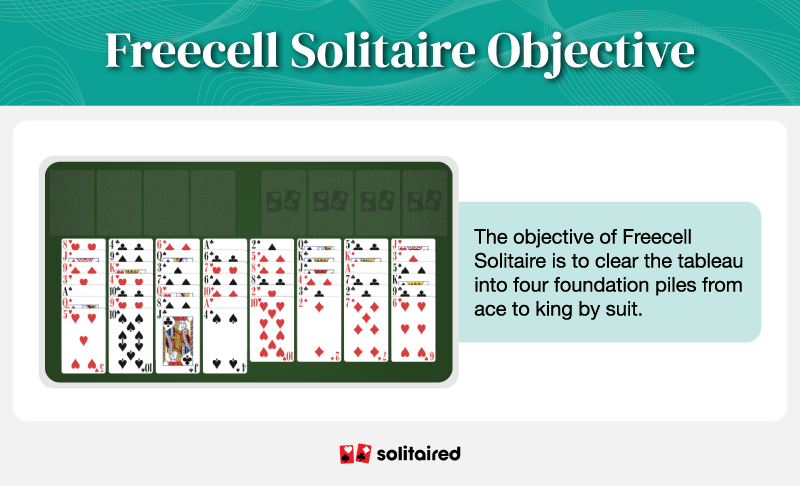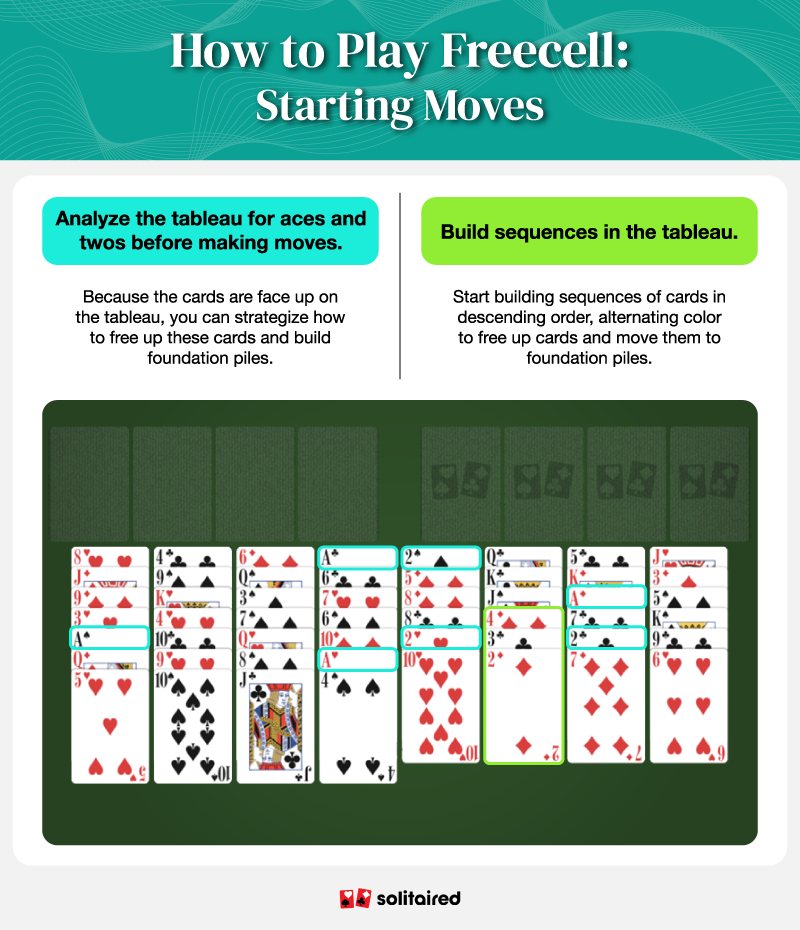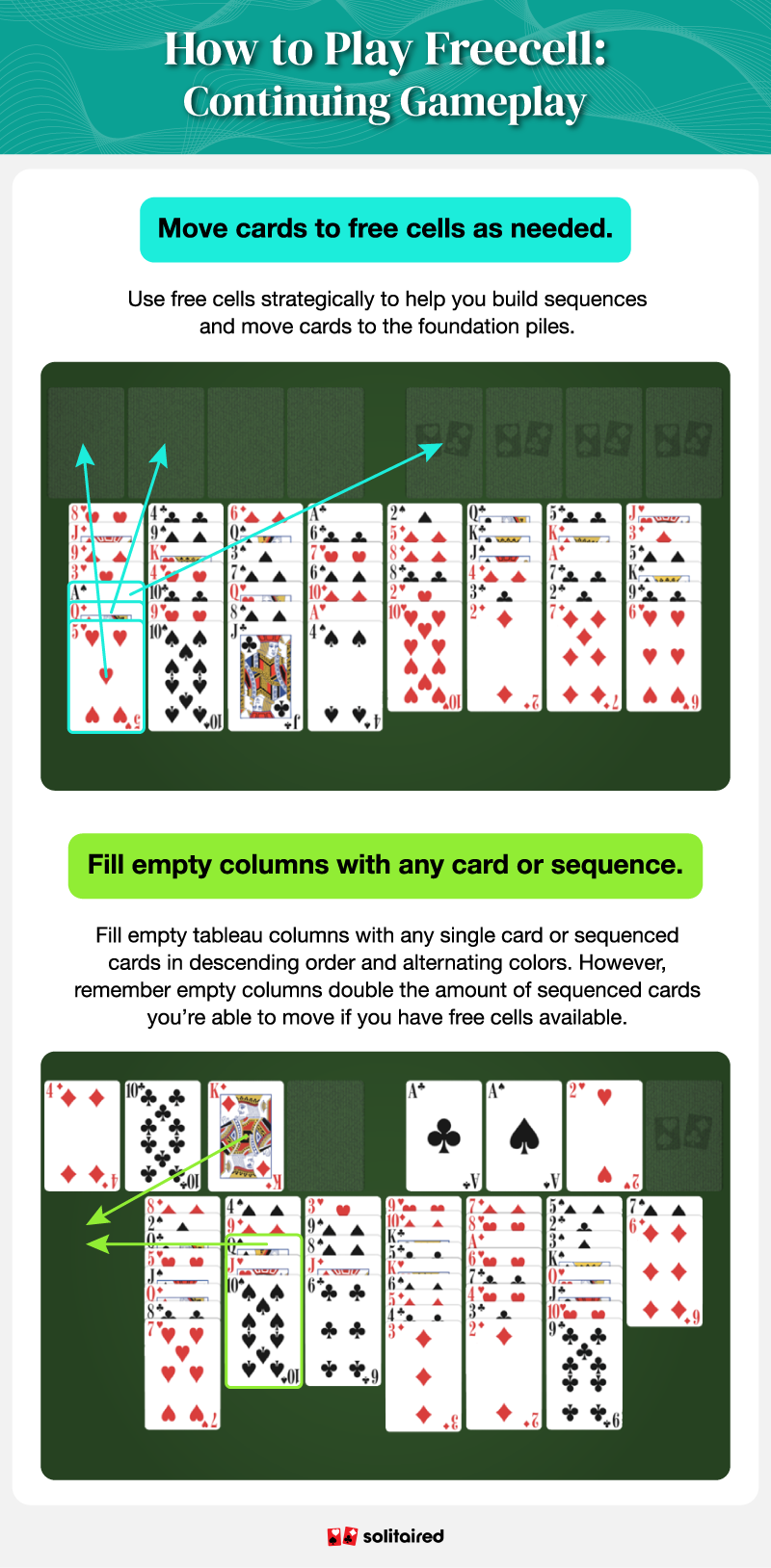How to Play FreeCell Solitaire [With Video Tutorial]
By Neal Taparia - 05/30/2024
FreeCell Solitaire is a one-player card game that gets its name from the four free cells above the tableau, which help you move and sequence cards. The goal of FreeCell is to arrange cards into four foundation piles from ace to king by suit, clearing the tableau.
Like other Solitaire games, it can either be played online or with a standard 52-card deck, but the main differentiator from other Solitaire variations is the free cells that help or hinder your moves.
Use this tutorial and video guide to understand how to play FreeCell and strategies to win.
FreeCell Objective

The object of the game is to clear the tableau into four foundation piles separated by suit, sequencing the cards from ace to king. Moving cards to free cells and within the tableau helps you do this.
To determine how many cards you can move within the tableau, add one to the number of cells available. Take a look below for an example:
- Four open free cells = player can move five sequenced cards at a time
- Three open free cells = player can move four sequenced cards at a time
- Two open free cells = player can move three sequenced cards at a time
- One open free cell = player can move two sequenced cards at a time
- No open free cells = player can move one card at a time
If there’s an empty tableau column, the number of cards you’re allowed to move is doubled as long as you're not moving a stack of cards into that empty column. For example, if you have three open free cells and an empty column, you can move a sequence of up to eight cards.
FreeCell Solitaire Setup

Setting up FreeCell is simple. Here are the important elements used in the game:
- Tableau: You place 52 playing cards face up into eight columns. The first four columns have seven cards face up, while the last four have six cards face up.
- Foundation piles: Four foundation piles should be located at the top right, where you sequence cards from ace to king by suit. Some refer to these piles as “home cells” for this variation.
- Free cells: Four free cells in the top left allow you to move exposed cards, or cards without any other cards stacked on top, from the tableau to the free cells. This lets you make more moves on the tableau. However, if all the free cell slots are taken up by cards, you can only make one move at a time. Unlike other Solitaire variations, such as Klondike or Spider Solitaire, there is no stockpile to draw from if you get stuck. So use the free cells like temporary placeholders to help you continue making moves throughout the game.
How to Play FreeCell Solitaire
To win the game, you must use the tableau and free cells to move the cards into the four foundation piles, stacking them by suit in ascending order from ace to king. If you cannot move any cards, you’ve lost the game.

1. Analyze the Tableau for Aces and Twos Before Making Moves
You can see every card since all the cards are face up from the beginning. You’ll want to carefully plan moves, though, since you only have four free spaces to use. If they’re easily accessible, move aces and twos to the foundation piles first so you can make more moves and use your free cells for other cards.
If your aces and twos are buried under other cards, strategize for efficient ways to free them without occupying too many free cells. Although you can move cards that cover the aces and twos into free cells, you need to build sequences to reach them if the aces and twos are too far up the column. Otherwise, you may fill up too many free cells and block subsequent moves.
2. Build Sequences in the Tableau
On the tableau, you’ll want to build sequences of cards from king to ace in opposite colors. You can later use those sequences to build up the foundation piles, getting rid of the cards on the tableau. For example, say you have a tableau column that consists of the two of diamonds, ten of diamonds, nine of clubs, and eight of diamonds. You need to access the two of diamonds to move it to the foundation pile, assuming there’s an ace of diamonds already in the foundation pile.
Now, in another column, there’s a king of clubs, queen of diamonds, and jack of clubs. Move the eight of diamonds and nine of clubs to two available free cells. The ten of diamonds can now be played on the jack of clubs. You’ll have freed the two of diamonds to play in the foundation pile. Meanwhile, you can move the nine of clubs and eight of diamonds onto the king, queen, jack, and ten sequence.
This way, you’ve moved a card into its foundation pile while also building a sequence in the tableau.

3. Move Cards to Free Cells As Needed
If you use the free cells carefully, they can be very helpful in allowing you to build sequences and move cards to the foundation piles.
As an example, let’s say you just moved the ace of clubs to its foundation pile. In another column, the six of spades is blocking the two of clubs. You may want to move it to a free cell to allow you to move the two to its foundation pile. You cannot move hidden cards on the tableau unless they’re in a sequence and you have enough open free cells to move sequences on the tableau.
Also remember, to move a sequence of cards, you need to use the free cells. The number of empty free cells available determines how many cards you can move, so remember to add one to the number of free cells to find how many cards you can move at once. For example, you can move one card if all your free cells are full (0 cells open + 1 = 1 card that can be moved) or five cards if all the free cells are open (4 cells open + 1 = 5 cards that can be moved). If a column is empty, the number of cards you can move is doubled as long as you’re not moving the cards to that column.
4. Fill Empty Columns with Any Card or Sequence of Cards
Once a tableau column is emptied, you can replace it with any single card or sequenced card you need, allowing you to continue to reorganize the tableau and win. However, you may want to keep columns empty, which will allow you to move longer sequences. For example, if you have two free cells open and an empty column, you can move a sequence of six cards as long as you place the sequence onto another card and not into that empty column. This could be a key to win as you progress through the game.
5. Move All Cards to the Foundation Piles to Win the Game
Because long sequences can block you from playing in this game, as soon as a card is free for the foundation pile, you can move it instead of saving it for a sequence. Unlike other variations, you can use empty columns in addition to free cells to move any rank of card, so moving cards to the foundation pile instead of building long sequences gets you closer to winning.
FreeCell Solitaire Strategies to Win
Here are some strategies to keep in mind as you play, helping you learn how to win the game while obeying the FreeCell rules:
- Move aces to the foundation piles immediately. This way, you free up cards in the tableau and you continue to make moves. You’re also able to move cards off the tableau onto the foundation piles, once you’ve placed the ace there as a base.
- Clearing columns allows you to keep moving cards around the tableau. For example, if you have one free cell open and an empty column, you can move a sequence of four cards. While it may be difficult to keep a column open, it will pay off in the long run.
- Avoid building long sequences. These can block cards hidden under the sequence and limit your flexibility to access cards you may need, keeping you at a standstill.
- Use free cells only if you can’t move on the tableau. You should try to only use the free cells for holding cards that block a card you want to play, and you should also try to move that card back down to the tableau if possible.
- Utilize the undo button if you see other moves that would keep you moving. You can only do this in the online version, but it helps you correct mistakes. If you’re playing in person, you should allow yourself to go back and correct plays if you find yourself stuck.
Other Solitaire Variations
Here are some other variants you can play with Solitaire card games, both online and in person.
- Baker’s Game: This game is set up just like classic FreeCell but instead of building by alternating colors, you can only build by suit. This makes this variation incredibly hard, decreasing the solve rate by 75%.
- Baker’s Dozen: This variation is a bit different as the set-up calls for 13 rows of four cards. Like FreeCell, the point of the game is to move the cards from the tableau to the foundation pile.
- Eight Off: This game has eight free cells, instead of four, but the gameplay is very much still like classic FreeCell. This is one of the easier versions to play.
- Alternations: This version requires two decks of cards, and it’s a combination of FreeCell and Klondike Solitaire. Since everything is double, you’ll need to build eight foundation piles, and because every other card is facedown, this is considered one of the harder Solitaire versions to play.
- Antares: In this game, you split the tableau in half. One side plays according to the rules of FreeCell, while the other plays according to the rules of Scorpion. The game setup is very similar to that of FreeCell.
- Big FreeCell: This version is the same as normal FreeCell, except you play with two decks of cards. This makes everything bigger, thus the name.
- Cell Eleven: Cell Eleven uses three decks of cards, and it uses 11 cells. However, two of these cells aren’t free and contain one card from the get-go.
Ready to Play FreeCell Solitaire?
Practice makes perfect, so try your best to continue to play FreeCell Solitaire as much as possible. The more you become familiar with the game, the more you’ll win.
Solitaired has other types of card games, including other variations of Solitaire, making this the best place for beginners. You don’t have to download or register to play on Solitaired, and you can log in, save your score, and begin competing with other FreeCell players.
About the author

